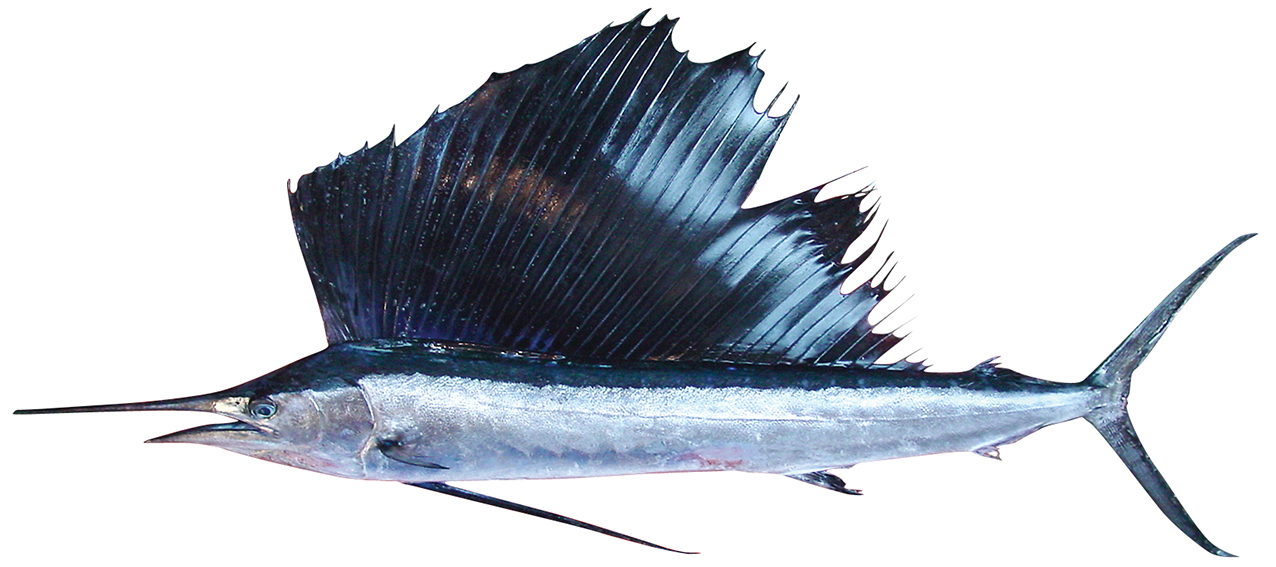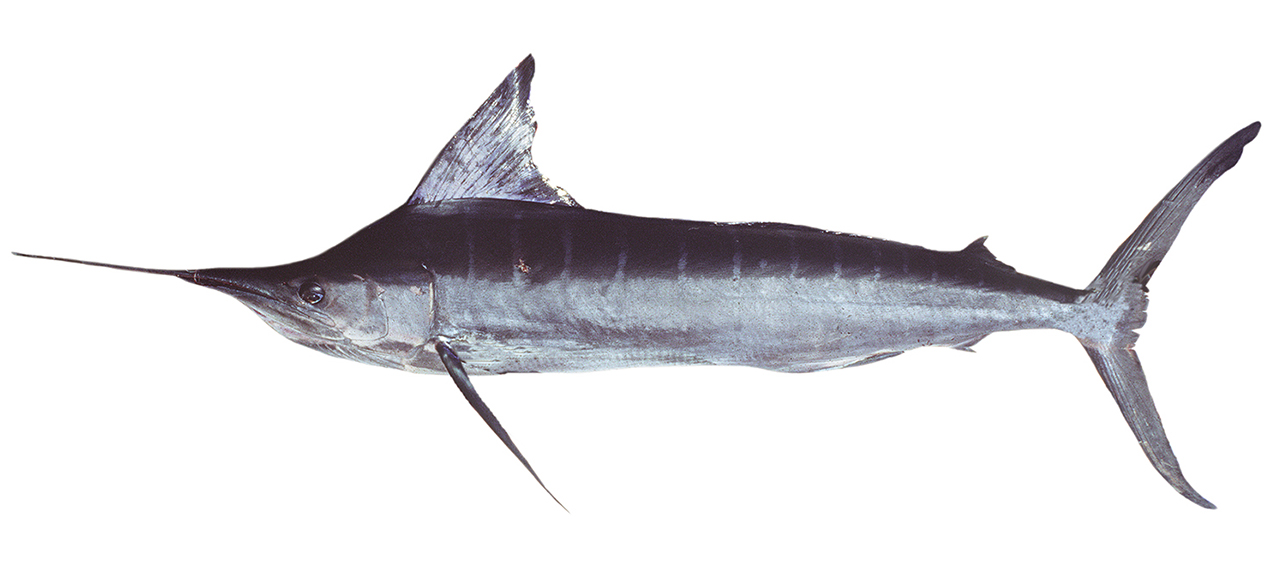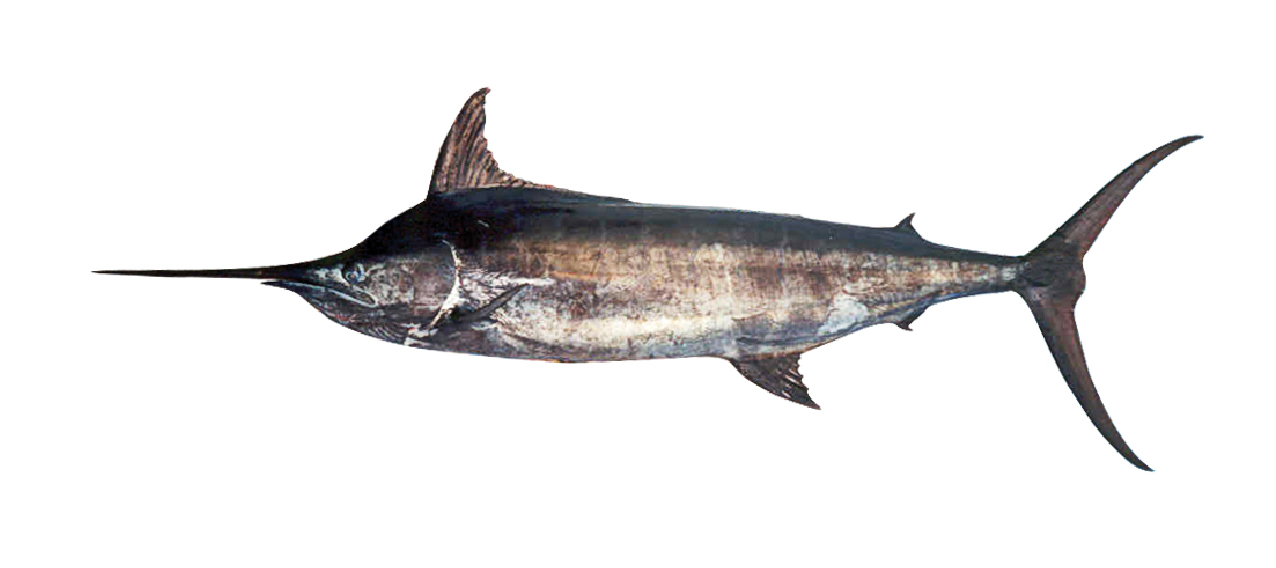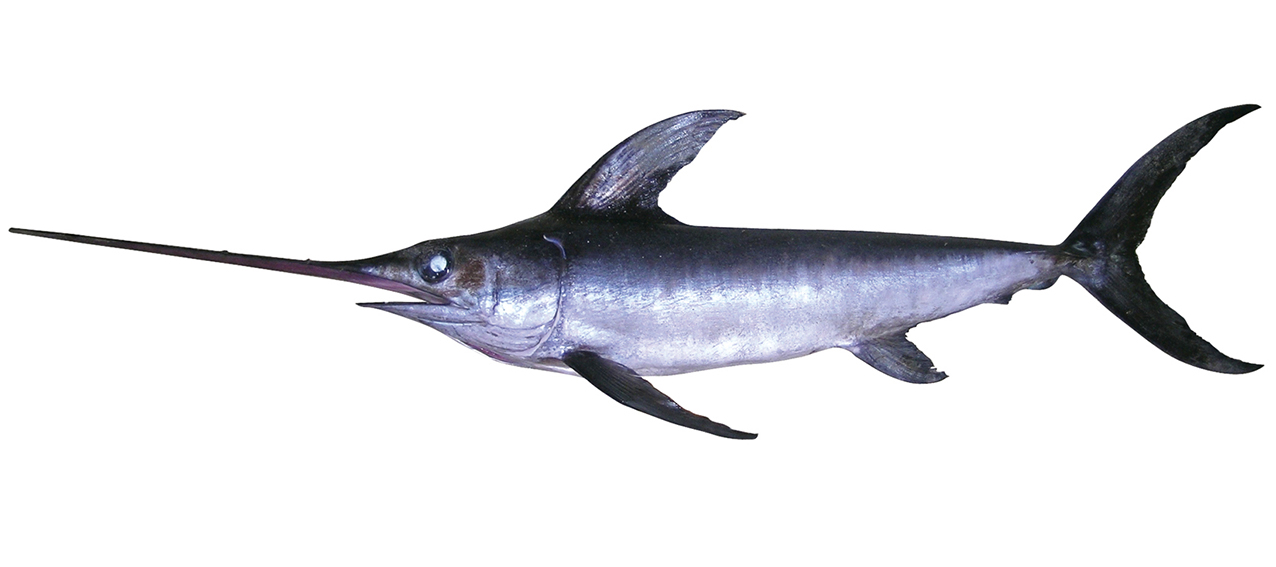Upper surfaces blackish to dark blue; bronze sheen along sides; silver below. All fins dark except anal fin which is pale. Juveniles sometimes show vertical stripes similar to that of striped marlin. Colours fading after death as condition is lost.
To 450 cm TL and up to 700 kg in weight.1
Juvenile ~ 85 cm LJFL

- First dorsal fin tall for much of its length
- Vertical stripes sometimes present
- Pectoral fins flexible in individuals less than around 15 kg, otherwise rigid, unable to be folded against body
Tropical and subtropical waters of the Indo–Pacific.
Epipelagic in oceanic waters, found at depths from the surface to at least 915 m.2
Highly migratory; most densely distributed in waters close to coasts and islands. Feeds mostly on small tuna but also other small fishes, crustaceans, and cephalopods. Size at 50% maturity estimated at 195 cm EFL, corresponding to 5.4 years of age for female black marlin off Taiwan.3 Maximum estimated age is 5–7 years for males and 11–13 years for females.4, 5
Caught predominantly by longlining and set netting, but also by gill netting.
Istiophorus platypterus
Sailfish

Istiophorus platypterus differs in having a sail-like dorsal fin, taller than maximum body depth along the majority of its length, tallest at mid-fin (vs. anterior portion of dorsal fin lower than body depth, posterior portion low) and pelvic-fin rays very long, almost reaching the anus (vs. short, far from reaching anus).
Kajikia audax
Striped marlin

Kajikia audax differs in having pectoral fins which are leaf shaped (vs. curved/sickle-shaped) and are able to be folded against the sides of body (vs. rigid, unable to be folded against sides of body); first dorsal fin with a pointed tip (vs. slightly rounded); anterior portion of first dorsal fin equal to or greater than body depth (vs. height about half body depth); second dorsal fin slightly posterior to second anal fin (vs. second dorsal fin slightly anterior to second anal fin) and flesh orange (vs. pinkish white to greyish).
Makaira nigricans
Blue marlin

Makaira nigricans differs in having pectoral fins which are strap like (vs. curved/sickle shaped) and flexible, able to be folded flat against sides of body (vs. rigid, unable to be folded against sides of body) and second dorsal fin slightly posterior to second anal fin (vs. second dorsal fin slightly anterior to second dorsal fin).
Tetrapturus angustirostris
Shortbill spearfish

Tetrapturus angustirostris differs in having a short bill, only slightly longer than lower jaw (vs. much longer than lower jaw); the anus located well anterior of first anal fin by a distance greater than the length of the first anal-fin base (vs. slightly anterior of the first anal fin by a distance less than length of the first anal-fin base) and a nape low to flat (vs. steep).
Xiphias gladius
Broadbill swordfish

Xiphias gladius differs in having a bill that is flat-oval in cross section (vs. rounded); pelvic fins absent (vs. present); 1 median keel on caudal peduncle (vs. 2 keels) and a deep notch on both upper and lower profiles on caudal peduncle (vs. shallow notches).
- IGFA. Database of IGFA angling records until 2001. IGFA Fort Lauderdale, USA; 2001.
- Nakamura I. FAO Fisheries catalogue Vol. 5. Billfishes of the world: An annotated and illustrated catalogue of marlins, sailfishes, spearfishes and swordfishes known to date. Food and Agriculture Organization of the United Nations; 1985.
- Sun C-L, Chang H-Y, Liu T-Y, Yeh S-Z, Chang Y-J. Reproductive biology of the black marlin, Istiompax indica, off southwestern and eastern Taiwan. Fisheries Research. 2015;166:12–20.
- Speare P. Age and growth of black marlin, Makaira indica, in east coast Australian waters. Marine and Freshwater Research. 2003;54(4):307–14.
- Sun C-L, Yeh S-Z, Liu C-S, Su N-J, Chiang W-C. Age and growth of Black marlin (Istiompax indica) off eastern Taiwan. Fisheries Research. 2015;166:4–11.
-
Osteichthyes
Bony Fish
-
-
Carangidae
Trevallies, queenfish, scads etc.
-
- Genus Alectis
- Genus Alepes
- Genus Gnathanodon
- Genus Megalaspis
- Genus Naucrates
- Genus Parastromateus
- Genus Selaroides
- Genus Seriolina
- Genus Atule
- Genus Elagatis
- Genus Carangoides
- Genus Decapterus
- Genus Caranx
- Genus Scomberoides
- Genus Selar
- Genus Seriola
- Genus Trachinotus
- Genus Ulua
-
- Genus Uraspis
-
Atropus atropos
Cleftbelly trevally
-
Serranidae
Groupers
-
- Genus Aethaloperca
-
- Genus Cephalopholis
-
-
Cephalopholis aitha
Rusty hind
-
Cephalopholis sonnerati
Tomato grouper
-
Cephalopholis argus
Peacock grouper
-
Cephalopholis cyanostigma
Bluespotted grouper
-
Cephalopholis miniata
Red coral grouper
-
Cephalopholis sexmaculata
Saddle grouper
-
Cephalopholis aurantia
Golden grouper
-
Cephalopholis boenak
Chocolate grouper
-
Cephalopholis microprion
Freckled grouper
-
Cephalopholis formosa
Bluelined grouper
-
Cephalopholis polleni
Harlequin grouper
-
Cephalopholis urodeta
Darkfin grouper
-
Cephalopholis spiloparaea
Strawberry grouper
-
Cephalopholis leopardus
Leopard grouper
-
Cephalopholis igarashiensis
Garish grouper
-
Cephalopholis aitha
- Genus Anyperodon
- Genus Caprodon
- Genus Chromileptes
- Genus Epinephelus
-
-
Epinephelus bontoides
Palemargin grouper
-
Epinephelus kupangensis
Kupang grouper
-
Epinephelus multinotatus
White-blotched grouper
-
Epinephelus morrhua
Comet grouper
-
Epinephelus quoyanus
Longfin grouper
-
Epinephelus spilotoceps
Foursaddle grouper
-
Epinephelus erythrurus
Cloudy grouper
-
Epinephelus polystigma
White-dotted grouper
-
Epinephelus amblycephalus
Banded grouper
-
Epinephelus sexfasciatus
Sixbar grouper
-
Epinephelus areolatus
Areolate grouper
-
Epinephelus bleekeri
Bleeker’s grouper
-
Epinephelus coeruleopunctatus
Whitespotted grouper
-
Epinephelus coioides
Orangespotted grouper
-
Epinephelus corallicola
Coral grouper
-
Epinephelus cyanopodus
Speckled grouper
-
Epinephelus undulosus
Wavylined grouper
-
Epinephelus epistictus
Dotted grouper
-
Epinephelus fasciatus
Blacktip grouper
-
Epinephelus flavocaeruleus
Blue and yellow grouper
-
Epinephelus heniochus
Brindle grouper
-
Epinephelus lanceolatus
Giant grouper
-
Epinephelus miliaris
Netfin grouper
-
Epinephelus retouti
Redtipped grouper
-
Epinephelus stictus
Blackdotted grouper
-
Epinephelus fuscoguttatus
Brownmarbled grouper
-
Epinephelus latifasciatus
Striped grouper
-
Epinephelus longispinis
Longspine grouper
-
Epinephelus maculatus
Highfin grouper
-
Epinephelus magniscuttis
Spotted grouper
-
Epinephelus malabaricus
Malabar grouper
-
Epinephelus ongus
Whitestreaked grouper
-
Epinephelus poecilonotus
Dotdash grouper
-
Epinephelus polyphekadion
Camouflage grouper
-
Epinephelus radiatus
Obliquebanded grouper
-
Epinephelus rivulatus
Halfmoon grouper
-
Epinephelus faveatus
Indian grouper
-
Epinephelus hexagonatus
Starspotted grouper
-
Epinephelus macrospilos
Snubnose grouper
-
Epinephelus melanostigma
Blackspot grouper
-
Epinephelus bontoides
- Genus Giganthias
- Genus Gracila
- Genus Liopropoma
-
-
Liopropoma swalesi
Swales' basslet
-
Liopropoma randalli
Indian basslet
-
Liopropoma multilineatum
Manyline perch
-
Liopropoma dorsoluteum
Yellowback basslet
-
Liopropoma collettei
Collette's basslet
-
Liopropoma lemniscatum
Ribbon basslet
-
Liopropoma mitratum
Pinstripe basslet
-
Liopropoma africanum
African basslet
-
Liopropoma susumi
Meteor perch
-
Liopropoma swalesi
- Genus Odontanthias
- Genus Plectranthias
- Genus Chelidoperca
-
- Genus Diploprion
-
Genus Variola
Lyretail
- Genus Plectropomus
- Genus Hyporthodus
-
Pseudanthias squamipinnis
Scalefin anthias
-
Sacura parva
Little fairy basslet
-
Selenanthias analis
Pearlspot fairy basslet
-
Epinephelus merra
Honeycomb grouper
-
Aethaloperca rogaa
Redmouth grouper
-
Stromateidae
Pomfrets
-
Coryphaenidae
Dolphinfishes
-
Balistidae
Triggerfishes
-
Haemulidae
Grunts, sweetlips
-
- Genus Diagramma
- Genus Plectorhinchus
-
-
Plectorhinchus albovittatus
Giant sweetlips
-
Plectorhinchus chaetodonoides
Harlequin sweetlips
-
Plectorhinchus chrysotaenia
Goldlined sweetlips
-
Plectorhinchus flavomaculatus
Yellowspotted sweetlips
-
Plectorhinchus gibbosus
Humpback sweetlips
-
Plectorhinchus lessonii
Striped sweetlips
-
Plectorhinchus lineatus
Lined sweetlips
-
Plectorhinchus polytaenia
Ribbon sweetlips
-
Plectorhinchus unicolor
Sombre Sweetlips
-
Plectorhinchus vittatus
Oriental sweetlips
-
Plectorhinchus pica
Painted sweetlip
-
Plectorhinchus albovittatus
- Genus Pomadasys
-
Monacanthidae
Leatherjackets
-
Lutjanidae
Snappers
-
- Genus Aphareus
- Genus Etelis
-
Genus Lutjanus
Snapper
-
-
Lutjanus dodecacanthoides
Sunbeam snapper
-
Lutjanus argentimaculatus
Mangrove jack
-
Lutjanus bengalensis
Bengal snapper
-
Lutjanus biguttatus
Twospot snapper
-
Lutjanus bitaeniatus
Indonesian snapper
-
Lutjanus bohar
Red bass
-
Lutjanus boutton
Button snapper
-
Lutjanus carponotatus
Spanish flag
-
Lutjanus decussatus
Chequered snapper
-
Lutjanus ehrenbergii
Ehrenberg's snapper
-
Lutjanus erythropterus
Crimson snapper
-
Lutjanus fulviflamma
Blackspot snapper
-
Lutjanus fulvus
Blacktail snapper
-
Lutjanus gibbus
Paddletail snapper
-
Lutjanus johnii
Golden snapper
-
Lutjanus kasmira
Common bluestripe snapper
-
Lutjanus lemniscatus
Darktail snapper
-
Lutjanus lunulatus
Lunartail snapper
-
Lutjanus lutjanus
Bigeye snapper
-
Lutjanus malabaricus
Malabar snapper
-
Lutjanus maxweberi
Pygmy snapper
-
Lutjanus mizenkoi
Mizenko's snapper
-
Lutjanus monostigma
Onespot snapper
-
Lutjanus papuensis
Papuan snapper
-
Lutjanus quinquelineatus
Fivelined snapper
-
Lutjanus rivulatus
Speckled snapper
-
Lutjanus rufolineatus
Goldenlined snapper
-
Lutjanus russellii
Russell's snapper
-
Lutjanus sebae
Red emperor
-
Lutjanus semicinctus
Black-banded snapper
-
Lutjanus timoriensis
Timor snapper
-
Lutjanus vitta
Brownstripe snapper
-
Lutjanus xanthopinnis
Yellowfin snapper
-
Lutjanus dodecacanthoides
- Genus Pristipomoides
-
-
Pristipomoides argyrogrammicus
Ornate jobfish
-
Pristipomoides auricilla
Goldflag jobfish
-
Pristipomoides filamentosus
Crimson jobfish
-
Pristipomoides flavipinnis
Goldeneye jobfish
-
Pristipomoides multidens
Goldband jobfish
-
Pristipomoides sieboldii
Lavender jobfish
-
Pristipomoides typus
Sharptooth jobfish
-
Pristipomoides zonatus
Oblique-banded snapper
-
Pristipomoides argyrogrammicus
- Genus Macolor
- Genus Paracaesio
- Genus Pinjalo
-
Lipocheilus carnolabrum
Tang's snapper
-
Symphorichthys spilurus
Sailfin snapper
-
Symphorus nematophorus
Chinamanfish
-
Aprion virescens
Green jobfish
-
Gempylidae
Snake mackerels
-
- Genus Rexea
-
Diplospinus multistriatus
Striped escolar
-
Nealotus tripes
Black snake mackerel
-
Neoepinnula orientalis
Sackfish
-
Nesiarchus nasutus
Black gemfish
-
Gempylus serpens
Snake mackerel
-
Lepidocybium flavobrunneum
Escolar
-
Promethichthys prometheus
Singleline Gemfish
-
Ruvettus pretiosus
Oilfish
-
Thyrsitoides marleyi
Black Snoek
-
Istiophoridae
Billfishes
-
Scombridae
Tunas & Mackerels
-
-
Genus Auxis
Frigate & bullet tunas
-
Genus Rastrelliger
Chub mackerel
-
Genus Scomberomorus
Mackerel
-
Genus Thunnus
True tunas
-
Acanthocybium solandri
Wahoo
-
Euthynnus affinis
Mackerel tuna
-
Grammatorcynus bilineatus
Double-lined mackerel
-
Gymnosarda unicolor
Dogtooth tuna
-
Katsuwonus pelamis
Skipjack tuna
-
Sarda orientalis
Striped bonito
-
Scomber australasicus
Blue mackerel
-
Genus Auxis
-
Xiphiidae
Broadbill swordfish
-
Sphyraenidae
Barracudas
-
Lethrinidae
Emperors
-
- Genus Gymnocranius
-
-
Gymnocranius elongatus
Forktail large-eye bream
-
Gymnocranius frenatus
Yellowsnout large-eye bream
-
Gymnocranius grandoculis
Blue-lined large-eye bream
-
Gymnocranius microdon
Bluespotted large-eye bream
-
Gymnocranius euanus
Japanese large-eye bream
-
Gymnocranius griseus
Grey large-eye bream
-
Gymnocranius satoi
Blacknape large-eye bream
-
Gymnocranius obesus
Obese large-eye bream
-
Gymnocranius elongatus
-
Genus Lethrinus
Emperor
-
-
Lethrinus atkinsoni
Yellowtail emperor
-
Lethrinus erythracanthus
Yellowfin emperor
-
Lethrinus erythropterus
Longfin emperor
-
Lethrinus genivittatus
Longspine emperor
-
Lethrinus harak
Thumbprint emperor
-
Lethrinus lentjan
Pinkear emperor
-
Lethrinus microdon
Smalltooth Emperor
-
Lethrinus nebulosus
Spangled emperor
-
Lethrinus obsoletus
Orangestriped Emperor
-
Lethrinus olivaceus
Longface emperor
-
Lethrinus ornatus
Ornate emperor
-
Lethrinus rubrioperculatus
Spotcheek emperor
-
Lethrinus semicinctus
Blackblotch emperor
-
Lethrinus variegatus
Slender emperor
-
Lethrinus xanthochilus
Yellowtip emperor
-
Lethrinus ravus
Drab emperor
-
Lethrinus reticulatus
Red snout emperor
-
Lethrinus conchyliatus
Maldive emperor
-
Lethrinus laticaudis
Grass emperor
-
Lethrinus miniatus
Trumpet emperor
-
Lethrinus atkinsoni
- Genus Monotaxis
-
Gnathodentex aureolineatus
Striped Large-eye Bream
-
Lethrinus amboinensis
Ambon emperor
-
Wattsia mossambica
Mozambique large-eye bream
-
Carangidae
-
Elasmobranchii
Cartilaginous Fish
-
-
Stegostomatidae
Zebra shark
-
-
Galeocerdidae
Tiger shark
-
Mobulidae
Manta and devil rays
-
Alopiidae
Thresher sharks
-
Lamnidae
Mackerel sharks
-
Carcharhinidae
Whaler sharks
-
- Genus Carcharhinus
-
-
Carcharhinus albimarginatus
Silvertip shark
-
Carcharhinus altimus
Bignose shark
-
Carcharhinus amblyrhynchoides
Graceful shark
-
Carcharhinus amblyrhynchos
Grey reef shark
-
Carcharhinus amboinensis
Pigeye shark
-
Carcharhinus borneensis
Borneo shark
-
Carcharhinus brevipinna
Spinner shark
-
Carcharhinus falciformis
Silky shark
-
Carcharhinus leucas
Bullshark
-
Carcharhinus limbatus
Common blacktip shark
-
Carcharhinus longimanus
Oceanic whitetip shark
-
Carcharhinus macloti
Hardnose shark
-
Carcharhinus melanopterus
Blacktip reef shark
-
Carcharhinus obscurus
Dusky shark
-
Carcharhinus plumbeus
Sandbar shark
-
Carcharhinus sealei
Blackspot shark
-
Carcharhinus sorrah
Spot-tail shark
-
Carcharhinus tilstoni
Australian blacktip shark
-
Carcharhinus tjutjot
Indonesian whaler shark
-
Carcharhinus albimarginatus
- Genus Rhizoprionodon
-
Glyphis gangeticus
Ganges shark
-
Lamiopsis tephrodes
Borneo broadfin shark
-
Loxodon macrorhinus
Sliteye shark
-
Negaprion acutidens
Sicklefin lemon shark
-
Prionace glauca
Blue shark
-
Scoliodon macrorhynchos
Pacific spadenose shark
-
Triaenodon obesus
Whitetip reef shark
-
Stegostomatidae
-
Crustaceans
Crabs, Lobsters, Shrimps, etc.